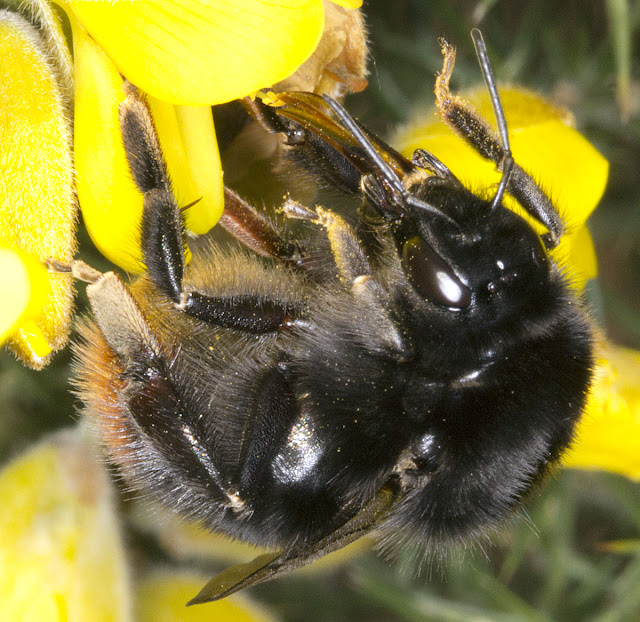 |
| Honey Bee, Apis mellifera. West Wickham Common, 21 March 2012. |
I have volunteered to do the weekly butterfly transects on one of my local commons this year, so I went up there on Wednesday to walk and memorise the route. While I was there I loitered by some gorse bushes. The sun was shining and I expected to see insects coming for the bright yellow flowers.
I saw these three bees. There was no rain, and I was very pleased to be able to use my SLR camera again, with its 100mm macro lens and ring flash. I have been longing to get some interesting detailed photos! Of these three, two, like Bee Fly I showed recently, only appear early in the year. Honey-bees like the one above will be around all summer. This one's pollen baskets are chock full, and she is also covered with loose pollen which will fertilise the other flowers she visits.
 |
| Bombus lapidarius queen. Bumblebee. West Wickham Common, 21 March 2012. |
Queen bumblebees like this one won't be seen after they establish their nests. Until then, they forage, as their smaller workers will continue to do later on. You can see that this one is tonguing up some pollen from the gorse flower's anthers. Her tongue is protected by harder mouthparts to either side.
 |
| Hairy-footed Flower Bee, Anthophora plumipes. Female. West Wickham Common, 21 March 2012. |
This one could be confusing. It looks rather like a bumblebee, but there are no all-black bumblers that I am likely to see, and anyway it was too small to be a queen. In between flowers, it hovered, so I thought I had one of those hoverflies that imitates bumblebees. But when I saw it close up I could see by its eyes, wings and antennae that it was definitely a bee, not a fly.
I had to look it up to discover that it's a Hairy-footed Flower Bee, and that only the females are this colour; black, with yellow hairs on the hind legs. These only fly in the spring. This photo shows her hovering. I was lucky to get this shot because she didn't stay around for long.



With the big camera and its ring flash, and you, that bombus lapidarius queen is simply spectacular.
ReplyDelete